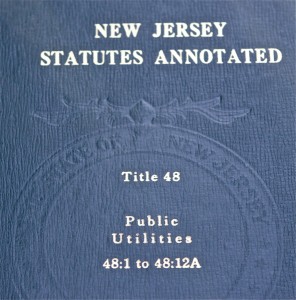Highlands Council Exempts Gas Pipeline Through the Heart of the Highlands
[Update: 2/26/12 – Looks like my initial assessment has some merit. A kind reader just sent me a note with a link to a Pennsylvania case where an Administrative Law Judge found that a gas pipeline was NOT a “public utility” as defined in statute. Regardless, the Highlands Council and the DEP, as regulatory agencies, lack the statutory authority to render this Legislative and/or quasi-judicial final determination:
In a 96-page decision, Judge Colwell blew several holes in the application. A midstream pipeline company, which delivers gas from the well head to the interstate pipeline, doesn’t meet the statutory definition of a public utility.
“A gathering line is specifically designed to serve producers … to transport gas to a designated transmission line and ultimately to a refinement facility. This is a business transaction,” she wrote. “Note the sharp contrast with the actions of a traditional gas utility … which permits property owners connect and consume gas in operating their heating and cooking appliances.”

NJSA 48:10-1 DOES regulate natural gas pipelines as public utility
[Update: Correction – portions of this post and my testimony were in error. I was thinking about “public utility” in terms of economic regulation of Tennessee’s profits.
So I just read the statute -and learned that natural gas pipelines are defined and regulated as public utilities, despite the lack of economic regulation of rate of return.]
I made my first observation of the new Christie Highlands Council last night (Tom Johnson at NJ Spotlight did a nice job covering the hearing – read his report here)
After seeing the environmental destruction wreaked by the Tennessee Gas Pipeline, and having fought their sweetheart DEP easement lease deals, I felt obligated to go.
I was under no illusions about the new Christie Highlands Council, particularly after getting personally involved in the nasty battle over the Chairmen Riley’s Senate confirmation. But it was far worse than I expected.
Director Eileen Swan seemed to be reading from a presentation prepared by Tennessee gas company. She presented photos that I believe were taken by Tennessee.
Her presentation of Tennessee’s proposed project and her various judgements about Tennessee’s performance were so consistently skewed, it was as if she were a Company lawyer.
Chairman Riley repeatedly interrupted and challenged members of the public who were testifying against the project.
Remarkably, Riley even scolded fellow Council members who asked tough questions, ruling that their inquiries were “inappropriate”.
Riley – I believe illegally – limited the scope of the public testimony to just 3 minor so called “new” issues. Riley repeatedly interrupted testimony to enforce that arbitrary and illegal restriction.
Riley interrupted my testimony – less than 10 seconds into it – as I attempted to introduce myself to the Council and provide expert qualifications in terms of having served as DEP staff to Governor McGreevey’s Highlands Task Force and as the sole DEP representative on the team that drafted Senator Smith’s bill, SB #1, which became the Highlands Act.
Knowing that the deal was already in and that the Council was going to approve the project, I raised 3 issues in my testimony:
1) Highlighting the disaster at Lake Lookover, I advised the Council to amend the Resolution to require that mitigation and project construction comply with DEP numeric surface water quality standards, and policies (NJAC 7:9B), especially the numeric standards for total dissolved solids (TDS) and total suspended solids (TSS). Those are enforceable regulatory standards.
The turbidity methodology and compliance values that they were using did not appear to comply with DEP TSS, TDS, or turbidity standards.
2) The Council should amend the Resolution to demand that DEP assess full market value for all Tennessee easement leases across state lands, in accordance with the methodology outlined in pending legislation (S826) recently released by the Senate Environment Committee.
Market value must be based on the economic value of the use of the easement, not the underlying assessed property value for development.
The benchmark market value would consider the PSEG/PPL mitigation value for the Delaware Water Gap S-R power line, $13 per square foot. At a minimum, DEP must recover at least what the NJ Turnpike Authority valued at $1.25 per square foot for fiber optic cables in the Turnpike ROW.
DEP’s policy of just $0.15 – no typo – 15 CENTS – per square foot is totally unacceptable.
3) Exemption #1 in Section 30 of the Highlands Act is limited to public utilities and the action by a public utility.
Specifically, in accordance with Section 30 of the Highlands Act, the following activity is exempt from the review requirements of the Highlands Act:
“(11) the route maintenance and operations, rehabilitation, preservation, reconstruction, repair, or upgrade of public utility lines, rights of way, or systems, by a public utility, provided that the activity is consistent with the goals and purposes of this act;” (emphasis mine)
The Tennessse Gas Company is a private for profit corporation, not a public utility.
As such, the exemption does not apply and Tennessee is ineligible for the exemption.
After public testimony, during the Council’s deliberations, Council member Kurt Alsteed, allegedly a farmer, summarized the arguments in favor of approving the project and granting the exemption as if he were reading from a Tennessee legal brief.
Several other Council members supported the project and spoke as if they were Tennessee shareholders, not public officials required to enforce the Highlands Act and serve as public stewards of public resources.
It was truly shameful.
[Update: and the shameful right wingnuttery low point, was when Councilman Walton supported the pipeline on the basis of preventing terrorism! You know, because all those Muslims that have control of oil we import are “looking to kill us” – I think the latter paraphrase about seeking to kill us is a literal verbatim quote. The first part about Muslims is my snark – but it was just below the surface of Walton’s low comments.
